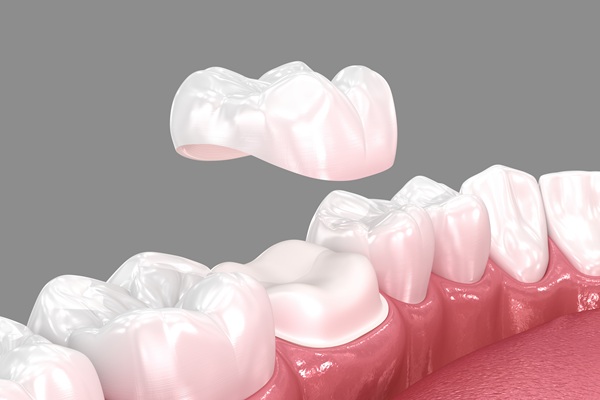The Dental Crown Placement Process

Getting a dental crown is a seamless procedure that is done in dental offices every day. There are various reasons to get a dental crown, which will play a role in how the process goes. For example, for those getting a crown to finish the tooth replacement process after an implant has been inserted, the process might take a few months. On the flip side, those having a dental crown placed to treat a cavity should expect the whole process to take a couple of weeks.
In general, there are a few key steps that are part of getting a dental crown placed. Being one of the most versatile ways to treat dental problems, crowns are a great option to consider. Keep reading to learn more about what is involved.
A guide to getting a dental crown
Outlined here are each of the steps to getting a dental crown placed. This information may be helpful to those who are preparing for an upcoming appointment.
1. Preparation
To start, the general dentist will prepare the oral cavity. Numbing agents will be administered into the cheek and gums surrounding the tooth requiring the dental crown. Usually, it takes 15-20 minutes maximum for a numbing agent to kick in. Additionally, some patients want to utilize a sedative, which may be light or moderate, depending on the purpose of the crown, the age of the patient, and the level of anxiety. Sedatives include laughing gas, otherwise known as nitrous oxide, as well as oral sedatives, which can be even more relaxing. These tools help to eliminate and manage dental anxiety or fear.
Next, a guard will be placed in the oral cavity to keep the patient from closing their jaw. Cotton pads may also be placed to keep extra saliva from getting in the way.
2. Removal of damaged parts
Using a dental drill, the damaged parts of the tooth will be carefully and gently removed if there is a cavity present. If the tooth is not decayed but simply damaged from a crack or chip, drilling will not likely be necessary. Instead, the tooth will simply be smoothed out to avoid rough surfaces. In the case of covering a severe stain or spot on the tooth, the dentist simply might etch the edges to ensure a good fit.
3. Cleaning out
If the tooth has been drilled, the dentist will also clean out the inner cavity. This is important in order to remove any bacteria or residue that could cause discomfort or infection later.
4. Filling the tooth
Next, a dental material called gutta-percha is used to fill the tooth if there is an open space. Filling the space is important because it keeps the insides of the tooth safe and secure before the dental crown is placed.
5. Taking impressions
Once the tooth has been filled, the dentist will take a quick impression of the tooth using a mold. This impression is then sent to the dental lab for the permanent dental crown. The permanent crown will be made of gold, other metals, porcelain, or a mixture at the dental lab, and it usually takes a couple of weeks to complete.
6. Crown placement
After the impression is taken for the permanent dental crown, the general dentist will place a temporary crown, which is made of composite resin. This is a dental material that is used for bonding, fillings, and other restorations. The temporary crown will be slightly cemented to keep it secure for a couple of weeks while the permanent piece is made.
The patient will return home, being advised to not eat anything sticky or hard for a few days. Any discomfort should subside or can be addressed with an over-the-counter pain reliever.
7. Permanent crown placement
The final step of getting a dental crown is having the permanent piece placed. After a couple of weeks, the patient will return to have their permanent crown placed on the tooth. The temporary will be removed and thrown away. The final crown will be cemented into place, making for a complete dental restoration. If there are abnormalities with the fit, the dentist will make the appropriate adjustments.
Find out more about getting a dental crown
When preparing for getting a dental crown, it can be helpful to talk directly with a general dentist. Reach out today to find out more or to get scheduled for an appointment.
Request an appointment here: https://www.mariavaldesgarcia.com or call South Florida Dentistry at (305) 203-4097 for an appointment in our Miami office.
Check out what others are saying about our dental services on Yelp: Dental Crowns in Miami, FL.
Related Posts
A dental crown and veneers are common dental treatments for restoring the appearance and functionality of your teeth. They can be used to restore damaged teeth and achieve a perfect smile depending on your dental condition. Although both dental crowns and veneers are useful tooth restoration options, the purpose, structure, and functionality of each differ.A…
Dental crowns are supposed to last forever, right? In the right set of circumstances, they could. Some crowns will last several decades while others will last a lifetime. Then there is the dental crown that comes loose for one reason or another. A loose crown means that a trip to the dentist is in the…
The time and effort that go into fitting a dental crown suggest a permanent restoration. Maybe it is the fact that installing a dental crown often requires multiple dentist visits. It could be the permanence that comes with the removal of enamel before the placement of a crown. Dental crowns that sit on dental implants…
When someone has had a root canal, people usually think of a dental crown as the next procedure. During a root canal, the dentist first drills a tiny hole in the tooth's surface. The infected pulp is then removed, and the inner layer of the tooth is cleaned to remove any residue. Finally, the dentist…
